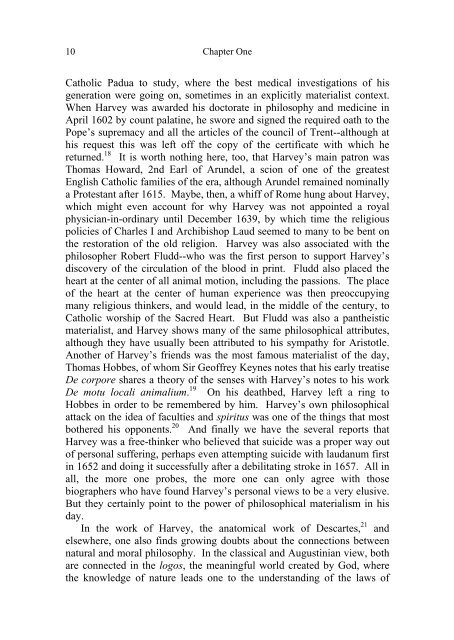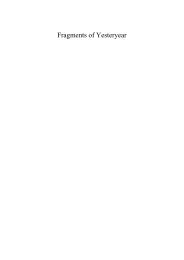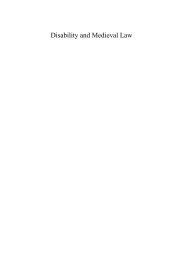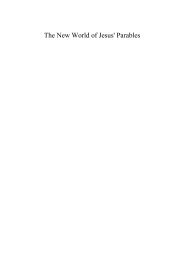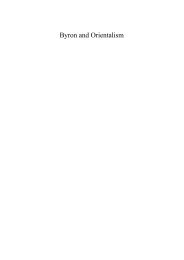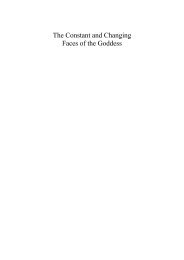The Gentleman, the Virtuoso, the Inquirer - Cambridge Scholars ...
The Gentleman, the Virtuoso, the Inquirer - Cambridge Scholars ...
The Gentleman, the Virtuoso, the Inquirer - Cambridge Scholars ...
Create successful ePaper yourself
Turn your PDF publications into a flip-book with our unique Google optimized e-Paper software.
10<br />
Chapter One<br />
Catholic Padua to study, where <strong>the</strong> best medical investigations of his<br />
generation were going on, sometimes in an explicitly materialist context.<br />
When Harvey was awarded his doctorate in philosophy and medicine in<br />
April 1602 by count palatine, he swore and signed <strong>the</strong> required oath to <strong>the</strong><br />
Pope’s supremacy and all <strong>the</strong> articles of <strong>the</strong> council of Trent--although at<br />
his request this was left off <strong>the</strong> copy of <strong>the</strong> certificate with which he<br />
returned. 18 It is worth nothing here, too, that Harvey’s main patron was<br />
Thomas Howard, 2nd Earl of Arundel, a scion of one of <strong>the</strong> greatest<br />
English Catholic families of <strong>the</strong> era, although Arundel remained nominally<br />
a Protestant after 1615. Maybe, <strong>the</strong>n, a whiff of Rome hung about Harvey,<br />
which might even account for why Harvey was not appointed a royal<br />
physician-in-ordinary until December 1639, by which time <strong>the</strong> religious<br />
policies of Charles I and Archibishop Laud seemed to many to be bent on<br />
<strong>the</strong> restoration of <strong>the</strong> old religion. Harvey was also associated with <strong>the</strong><br />
philosopher Robert Fludd--who was <strong>the</strong> first person to support Harvey’s<br />
discovery of <strong>the</strong> circulation of <strong>the</strong> blood in print. Fludd also placed <strong>the</strong><br />
heart at <strong>the</strong> center of all animal motion, including <strong>the</strong> passions. <strong>The</strong> place<br />
of <strong>the</strong> heart at <strong>the</strong> center of human experience was <strong>the</strong>n preoccupying<br />
many religious thinkers, and would lead, in <strong>the</strong> middle of <strong>the</strong> century, to<br />
Catholic worship of <strong>the</strong> Sacred Heart. But Fludd was also a pan<strong>the</strong>istic<br />
materialist, and Harvey shows many of <strong>the</strong> same philosophical attributes,<br />
although <strong>the</strong>y have usually been attributed to his sympathy for Aristotle.<br />
Ano<strong>the</strong>r of Harvey’s friends was <strong>the</strong> most famous materialist of <strong>the</strong> day,<br />
Thomas Hobbes, of whom Sir Geoffrey Keynes notes that his early treatise<br />
De corpore shares a <strong>the</strong>ory of <strong>the</strong> senses with Harvey’s notes to his work<br />
De motu locali animalium. 19 On his deathbed, Harvey left a ring to<br />
Hobbes in order to be remembered by him. Harvey’s own philosophical<br />
attack on <strong>the</strong> idea of faculties and spiritus was one of <strong>the</strong> things that most<br />
bo<strong>the</strong>red his opponents. 20 And finally we have <strong>the</strong> several reports that<br />
Harvey was a free-thinker who believed that suicide was a proper way out<br />
of personal suffering, perhaps even attempting suicide with laudanum first<br />
in 1652 and doing it successfully after a debilitating stroke in 1657. All in<br />
all, <strong>the</strong> more one probes, <strong>the</strong> more one can only agree with those<br />
biographers who have found Harvey’s personal views to be a very elusive.<br />
But <strong>the</strong>y certainly point to <strong>the</strong> power of philosophical materialism in his<br />
day.<br />
In <strong>the</strong> work of Harvey, <strong>the</strong> anatomical work of Descartes, 21 and<br />
elsewhere, one also finds growing doubts about <strong>the</strong> connections between<br />
natural and moral philosophy. In <strong>the</strong> classical and Augustinian view, both<br />
are connected in <strong>the</strong> logos, <strong>the</strong> meaningful world created by God, where<br />
<strong>the</strong> knowledge of nature leads one to <strong>the</strong> understanding of <strong>the</strong> laws of


